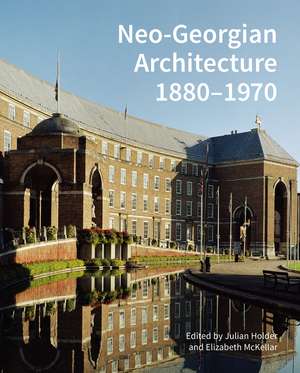Neo-Georgian Architecture 1880-1970
Editat de Julian Holder, Elizabeth McKellaren Limba Engleză Hardback – 14 mai 2016
Neo-Georgian design, which began with a revival of the Georgian ideals of symmetry and classical proportion in the late nineteenth century, has exerted a powerful and enduring influence on English-language cultures around the world. Neo-Georgian Architecture 1880-1970 assesses the impact of this movement through a consideration of the buildings, objects, institutions, and actors involved, contending that Neo-Georgianism was not simply another dying gasp of Revivalism but a complex assertion of national image and identity with a complicated, and at times fraught, relationship to modernism.
Preț: 449.65 lei
Preț vechi: 555.12 lei
-19% Nou
Puncte Express: 674
Preț estimativ în valută:
86.04€ • 90.06$ • 71.61£
86.04€ • 90.06$ • 71.61£
Carte indisponibilă temporar
Doresc să fiu notificat când acest titlu va fi disponibil:
Se trimite...
Preluare comenzi: 021 569.72.76
Specificații
ISBN-13: 9781848022355
ISBN-10: 1848022352
Pagini: 256
Ilustrații: 65 color plates, 85 halftones
Dimensiuni: 216 x 279 x 25 mm
Greutate: 1.23 kg
Editura: Historic England Publishing
Colecția Historic England Publishing
ISBN-10: 1848022352
Pagini: 256
Ilustrații: 65 color plates, 85 halftones
Dimensiuni: 216 x 279 x 25 mm
Greutate: 1.23 kg
Editura: Historic England Publishing
Colecția Historic England Publishing
Notă biografică
Julian Holder is a lecturer in the history and theory of architecture at the University of Salford. He is the author of Ancoats and Manchester’s Northern Quarter. Elizabeth McKellar is professor of architectural and design history at the Open University. She is the author of Landscape of London.
Cuprins
Notes on Contributors
Acknowledgements
Foreword by Louise Campbell
1 Introduction: reappraising the Neo-Georgian
Julian Holder and Elizabeth McKellar
Part I: Origins of the Neo-Georgian
2 Quality in Quality Street: Neo-Georgian and its place in architectural history
Alan Powers
3 the call to order: Neo-Georgian and the Liverpool School of Architecture
Peter Richmond
4 Georgian London before Georgian London: Beresford Chancellor Rasmussen and ‘The true and sad story of the Regent’s Street’
Elizabeth McKellar
Part II: Developing the Neo-Georgian language
5 Edwin Lutyens: Wrenaissance to Neo-Georgian
Margaret Richardson
6 Emanuel Vincent Harris: civic, civil and sane
Julian Holder and Nick Holmes
7 Giles Gilbert Scott and Classical architecture
Gavin Stamp
8 C H James: Neo-Georgian – from the small house to the town hall
Nick Chapple
Part III: Establishing a new tradition: typologies of the Neo-Georgian
9 Banker’s Georgian
Neil Burton
10 A state of approval: Neo-Georgian architecture and His Majesty’s Office of Works, 1914–1939
Julian Holder
11 Neo-Georgian: the other style in Britain’s 20th-century university architecture?
William Whyte
Part IV: Neo-Georgian: a prelude to modernism?
12 ‘Modern Swedish Rococo’: the Neo-Georgian interior in Britain, c 1920– c 1945
Clare Taylor
13 ‘A live universal language’: the Georgian as motif in interwar English architectural modernism
Elizabeth Darling
Part V: Global Neo-Georgian
14 The Neo-Georgian in New Zealand, 1918– 1939: architectural revivalism at the end of empire
Ian Lochhead
15 ‘Phony coloney’: the reception of the Georgian and the construction of 20th-century America
Stephen Hague
Index
Acknowledgements
Foreword by Louise Campbell
1 Introduction: reappraising the Neo-Georgian
Julian Holder and Elizabeth McKellar
Part I: Origins of the Neo-Georgian
2 Quality in Quality Street: Neo-Georgian and its place in architectural history
Alan Powers
3 the call to order: Neo-Georgian and the Liverpool School of Architecture
Peter Richmond
4 Georgian London before Georgian London: Beresford Chancellor Rasmussen and ‘The true and sad story of the Regent’s Street’
Elizabeth McKellar
Part II: Developing the Neo-Georgian language
5 Edwin Lutyens: Wrenaissance to Neo-Georgian
Margaret Richardson
6 Emanuel Vincent Harris: civic, civil and sane
Julian Holder and Nick Holmes
7 Giles Gilbert Scott and Classical architecture
Gavin Stamp
8 C H James: Neo-Georgian – from the small house to the town hall
Nick Chapple
Part III: Establishing a new tradition: typologies of the Neo-Georgian
9 Banker’s Georgian
Neil Burton
10 A state of approval: Neo-Georgian architecture and His Majesty’s Office of Works, 1914–1939
Julian Holder
11 Neo-Georgian: the other style in Britain’s 20th-century university architecture?
William Whyte
Part IV: Neo-Georgian: a prelude to modernism?
12 ‘Modern Swedish Rococo’: the Neo-Georgian interior in Britain, c 1920– c 1945
Clare Taylor
13 ‘A live universal language’: the Georgian as motif in interwar English architectural modernism
Elizabeth Darling
Part V: Global Neo-Georgian
14 The Neo-Georgian in New Zealand, 1918– 1939: architectural revivalism at the end of empire
Ian Lochhead
15 ‘Phony coloney’: the reception of the Georgian and the construction of 20th-century America
Stephen Hague
Index
